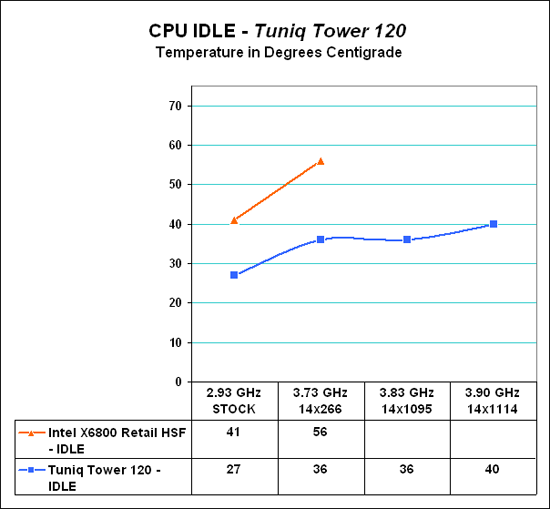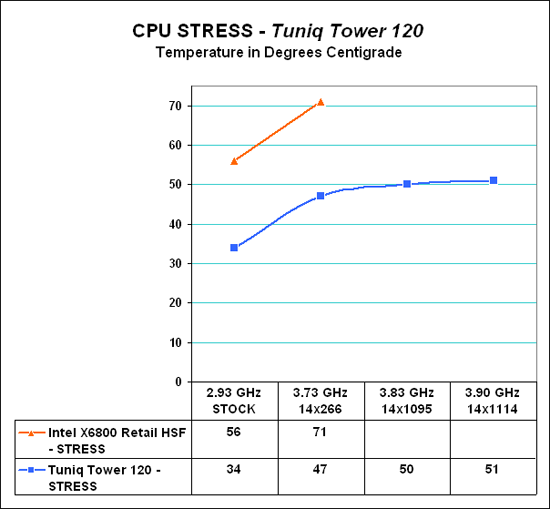Tuniq Tower 120: Air Cooling to the Max
by Wesley Fink on January 15, 2007 12:01 AM EST- Posted in
- Cases/Cooling/PSUs
Cooling Results
Both the retail Intel X6800 HSF and the Tuniq Tower 120 perform well at idle. Even at this base level, however, the effectiveness of the Tuniq Tower 120 is still clear.
Where the very good Intel stock cooler keeps the X6800 at 41C, the Tuniq manages 27C, which is a huge difference at stock idle speeds. As the processor is pushed to its highest stable overclock using the retail HSF, the delta increases. At 3.73GHz the retail HSF is running at 56C, compared to an extremely cool 36C with the Tuniq at the same speed. The Tuniq allows the X6800 to reach even higher overclocks, to a stable 3.90 GHz. Even at the maximum overclock on this CPU with the Tuniq, idle temperature is still a modest 40C, less than the stock speed temperature of the retail Intel HSF.
It is very easy to measure the effectiveness of a cooling solution at idle - when the computer is doing nothing except running the temperature measurement program. It is more difficult, however, to effectively simulate a computer being stressed by all of the conditions it might be exposed to in different operating environments. Frankly, for most home users CPU power is most taxed with contemporary gaming. Therefore our stress test simulates running a demanding contemporary game.
The Far Cry River demo is looped for 30 minutes and the CPU temperature is captured at 4 second intervals with the NVIDIA monitor "logging" option. The highest temperature during the stress test is then reported. We did try other variations in "stressing" the CPU. One option was multi-tasking running Super Pi with the Far Cry River looping. This did almost halve gaming frame rates and push CPU utilization to near a constant 100%. The multitasking test setup, however, did not produce higher temperatures than looping the Far Cry River demo. For that reason, we settled on the simple stress test of looping a demanding Far Cry demo for 30 minutes.
Cooling effectiveness compared to the retail HSF improves even more with the Tuniq Tower 120 when measured under stress conditions. It appears the Tuniq becomes even more effective as greater demands are placed on cooling.

The delta under stress conditions at stock 2.93GHz speed is 22C - 56C to 34C. This compares to the delta at stock idle of 14C. As we saw with idle speeds, the difference increased as we overclocked, with a difference of 24C (71C to 47C) at the 3.73GHz overclock. With the Tuniq speed could be pushed another 170 MHz to 3.90 GHz, with the stress CPU temperature of 51C - still 5C below the stress temperature of the retail HSF at stock speeds.
It would be an understatement to say the performance of the Tuniq 120 is impressive in cooling the CPU. In all cases the Tuniq cooled the CPU better than the stock Intel retail HSF under the same conditions at stock speed. This was true even with the X6800 pushed about 1000MHz beyond the fastest available Core 2 Duo CPU.
As for the overclocking abilities of the CPU, they will vary at the top. This particular CPU does higher FSB speeds than any X6800 we have tested, but the 3.9GHz top speed is pretty average among this CPU cooled with the Tuniq Tower 120. A few of the other processors tested with the Tuniq reach just over 4 GHz, but the range has been 3.8 to 4.0GHz. Stock cooling generally tops out 200 to 400Mhz lower, depending on the CPU, on the processors tested in our lab.










50 Comments
View All Comments
EWAXMAN - Sunday, January 6, 2008 - link
TO WHOM THIS MAY CONCERN,
I WOULD LIKE TO SEE A TEST RUN ON THE "ASUS TRITON 77 CPU COOLING FAN" COMPARED TO: THE TUNIQ TOWER 120, THE ZALMAN 9500 LED, AND THE ZALMAN 9700 LED - FOR OVERCLOCKING PURPOSES.
TESTED ON AN INTEL DUAL CORE CPU's 1.86 GHZ 65nm's AND UP, FOR COOLING, EASE OF INSTALLATION, PLUS NOISE FACTOR AS WELL.
THANK YOU IN ADVANCE, FOR YOUR CONSIDERATION, TIME, AND HELP.
RESPECTFULLY SUBMITTED,
EWAXMAN
EWAXMAN - Sunday, January 6, 2008 - link
I WOULD LIKE TO SEE A TEST RUN ON THE "ASUS TRITON 77 CPU COOLING FAN" COMPARED TO: THE TUNIQ TOWER 120, THE ZALMAN 9500 LED, AND THE ZALMAN 9700 LED - FOR OVERCLOCKING PURPOSES.TESTED ON AN INTEL DUAL CORE CPU's 1.86 GHZ 65nm's AND UP, FOR COOLING, EASE OF INSTALLATION, PLUS NOISE FACTOR AS WELL.
THANK YOU IN ADVANCE, FOR YOUR CONSIDERATION, TIME, AND HELP.
RESPECTFULLY SUBMITTED,
EWAXMAN
LoneWolf15 - Wednesday, January 17, 2007 - link
Maybe I missed it...were the temperature results for the Tuniq tower obtained with the fan on minimum or maximum RPM?orion23 - Tuesday, January 16, 2007 - link
So Anandtech, I mean, Anandtech reviews this great cooler and the test that was run compares it to Intel's stock cooler?And the load temperatures are taken from a game and not Orthos, or the well know Prime95?
And what happened, You guys couldn't get a Zalman or Thermalright Cooler to test the tuniq against?
What is wrong with Anandtech?
Jodiuh - Tuesday, January 16, 2007 - link
Most folks use Core Temp to monitor temps since it works the same across all boards. As it stands, only 680i users can compare.And why not use Orthos, the OCer's fav testing tool? It gets temps up pretty high and lets us know how stable a system is.
PrinceGaz - Tuesday, January 16, 2007 - link
You reported the temperatures at stock (2.93GHz) and at 3.73GHz for the standard cooler and the Tuniq Tower 120, and also at 3.83 and 3.9GHz for the TT120, but was the CPU running at the same core-voltage for all these different speeds? Presumably it was running at stock voltage for the stock speed run, so was 3.73GHz and 3.9GHz the maximum it could reach at stock voltage with the two heatsinks, or was the voltage increased (and by how much) to reach those speeds?For pure temperature comparisons between HSFs, keeping the voltage the same is obviously a must. However if the voltage was kept at stock (or at the same raised voltage) for determining the maximum overclock then you are probably missing out on a major advantage of a better cooler which is that you can crank the voltage up somewhat higher and still have a safe temperature.
Overclocking a CPU generally consists of seeing how fast it is stable at, then add a bit more voltage and see how much further it goes (while watching the temps), then a bit more voltage, and so on until the temperature reaches the highest you are happy with. The better HSF will allow a higher voltage to be used and that will usually translate to a higher overclock. Okay, so the overclocked temperature may be just as high with the better HSF when you use that approach, but it should provide a better indication of how much higher you can overclock the CPU with it.
Jiggz - Monday, January 15, 2007 - link
With it's monstrous size and weight, you would think they will design something for a vertically oriented mobo; which by the way most of us have.monsoon - Monday, January 15, 2007 - link
Does anyone know about a good / slick / cheap ( any of those criteria is welcome ) CASE where to install HORIZONTALLY a regular ATX MoBo so that I don't have to worry about the weight of the cooler ?THANKS !=)
Axbattler - Monday, January 15, 2007 - link
Though it is a little redundant (given that I don't see people mounting AMD fans on Intel chips and vice-versa), I am a little curious how well the AMD Stock fan compares to the Tuniq tower, and by association, how well it compares to the Intel.I remember that AMD's heatpipe cooler, used in the Dual-Core Opteron (and probably some other chips) have been very well regarded in various reviews. At the time, it was often thought that AMD's stock cooling solution was a good few steps ahead of Intels. Of course, it is hard to tell if part of the reason may not have been with the sheer amount of heat generated by those P4s, which is why I am curious how the two compares today.
Araemo - Monday, January 15, 2007 - link
I'd guess that that "good" dual core opteron heatpipe heatsink is a good unit. I purchased one in the FT/FS forums after I got my Opteron 148 (Single core, standard A64 heatsink), and with nothing but a little AS5, it was able to get my Opteron stable at 2.4 Ghz(over 1.8) with almost no extra voltage (I was only able to add 0.05V over the stock on my motherboard).That all said.. good luck getting a fair comparison with the Core 2 duo heatsinks.. You can't mount them on AMD and you can't mount the AMD(Socket 939) cooler on Intel(LGA775), as far as I can recall. I seem to recall that a few years back Anandtech(I think it was AT anyways.. I could be mistaken) built a 'cpu simulator' that had little metal ingots with heaters and temperature probes embedded to do apples-to-apples heatsink testing... I wonder if that's a realistic option for this roundup?